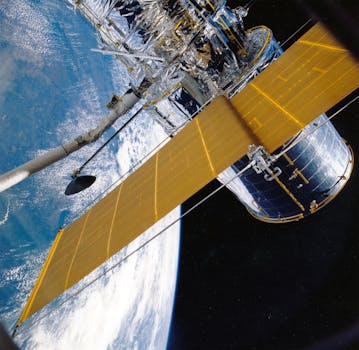
Beyond Earth: How Recent Advances in Satellite Tech are Shaping Global Communications
Beyond Earth: How Recent Advances in Satellite Tech are Shaping Global Communications. The advent of satellite technology has been a game-changer for global communications. With the ability to transmit data, voice, and video signals through space, satellite tech has enabled people from all over the world to stay connected, access information, and conduct business. Recent advances in satellite technology have further accelerated this trend, paving the way for faster, more reliable, and more accessible global communications.
One of the significant advantages of satellite technology is its ability to provide coverage in remote and underserved areas. Traditional telecommunications infrastructure, such as fiber optic cables and cell towers, can be expensive and difficult to deploy in these areas. Satellite technology, on the other hand, can provide coverage to these areas without the need for extensive infrastructure, making it an attractive solution for bridging the digital divide. For instance, satellite-based internet services, such as those provided by HughesNet and Exede Internet, have been instrumental in providing broadband access to rural and remote communities in the United States.
Advances in Satellite Technology
Recent advances in satellite technology have led to the development of more efficient, compact, and powerful satellites. The use of advanced materials and designs has enabled the creation of smaller and lighter satellites that can be launched into space at a lower cost. This has led to an increase in the number of satellite launches, with many companies, such as SpaceX and OneWeb, launching constellations of satellites into low Earth orbit. These constellations are designed to provide global coverage, enabling the provision of high-speed internet, voice, and data services to users around the world.
Another significant advancement in satellite technology is the development of high-throughput satellites (HTS). HTS satellites are designed to provide high-speed internet services, with some satellites offering speeds of up to 100 Gbps. This is made possible through the use of advanced technologies, such as beamforming and frequency reuse, which enable the efficient use of satellite bandwidth. HTS satellites have been instrumental in providing broadband access to underserved areas, as well as supporting the growth of emerging technologies, such as the Internet of Things (IoT) and 5G networks.
Impact on Global Communications
The impact of recent advances in satellite technology on global communications has been significant. Satellite technology has enabled the provision of high-speed internet services to remote and underserved areas, bridging the digital divide and providing access to information, education, and economic opportunities. Satellite technology has also enabled the growth of emerging technologies, such as IoT and 5G networks, by providing the necessary infrastructure to support their deployment.
Satellite technology has also played a critical role in supporting global communications during times of crisis. For instance, during natural disasters, such as hurricanes and earthquakes, satellite technology has been used to provide emergency communications services, enabling first responders to coordinate their efforts and providing vital information to affected communities. Satellite technology has also been used to support humanitarian efforts, such as providing internet access to refugees and displaced persons.
Challenges and Opportunities
Despite the many advances in satellite technology, there are still challenges to be addressed. One of the significant challenges facing the satellite industry is the issue of space debris. The increasing number of satellites in orbit has led to a growing concern about the risk of collisions and the impact of space debris on the environment. The industry is working to address this issue through the development of sustainable practices, such as the use of reusable rockets and the design of satellites that can be easily de-orbited at the end of their lifespan.
Another challenge facing the satellite industry is the issue of regulatory frameworks. The satellite industry is subject to a complex array of regulations, which can vary from country to country. The industry is working to address this issue through the development of harmonized regulatory frameworks, which will enable the satellite industry to operate more efficiently and effectively. For instance, the International Telecommunication Union (ITU) has been working to develop global standards for satellite communications, which will help to facilitate the growth of the industry.




